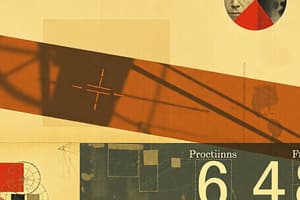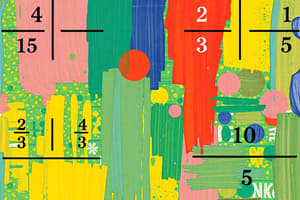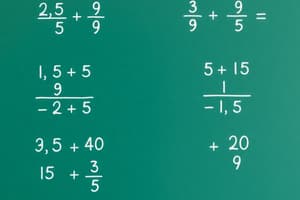Podcast
Questions and Answers
What defines a proper fraction?
What defines a proper fraction?
- The numerator is equal to zero.
- The numerator is greater than the denominator.
- The numerator is less than the denominator. (correct)
- The numerator and denominator are equal.
Which of the following statements correctly describes an improper fraction?
Which of the following statements correctly describes an improper fraction?
- The numerator is greater than or equal to the denominator. (correct)
- The numerator is less than the denominator.
- Both the numerator and denominator are whole numbers.
- The numerator is equal to the denominator.
A mixed fraction consists of what components?
A mixed fraction consists of what components?
- A proper fraction and an improper fraction.
- A proper fraction and a whole number.
- A whole number and an improper fraction. (correct)
- An integer and a decimal.
Which fraction type is NOT characterized by having a numerator less than the denominator?
Which fraction type is NOT characterized by having a numerator less than the denominator?
How would you classify the fraction 7/4?
How would you classify the fraction 7/4?
What does the top number in a fraction represent?
What does the top number in a fraction represent?
How is a fraction generally written?
How is a fraction generally written?
What does the bottom number in a fraction indicate?
What does the bottom number in a fraction indicate?
What is the primary function of a fraction?
What is the primary function of a fraction?
In the fraction $\frac{1}{2}$, what does the fraction represent?
In the fraction $\frac{1}{2}$, what does the fraction represent?
What is the first step in multiplying fractions?
What is the first step in multiplying fractions?
Which of the following represents the correct multiplication of the fractions $\frac{5}{6}$ and $\frac{2}{3}$?
Which of the following represents the correct multiplication of the fractions $\frac{5}{6}$ and $\frac{2}{3}$?
What is the result when reducing the fraction $\frac{10}{18}$ to its lowest terms?
What is the result when reducing the fraction $\frac{10}{18}$ to its lowest terms?
Which statement is true regarding the multiplication of $\frac{3}{5}$ and $\frac{1}{2}$?
Which statement is true regarding the multiplication of $\frac{3}{5}$ and $\frac{1}{2}$?
After multiplying the fractions, what is the next step?
After multiplying the fractions, what is the next step?
What is the product of $\frac{3}{5}$ and $\frac{1}{2}$ before reduction?
What is the product of $\frac{3}{5}$ and $\frac{1}{2}$ before reduction?
What is a common mistake students make when multiplying fractions?
What is a common mistake students make when multiplying fractions?
If you multiply $\frac{5}{6}$ by $\frac{2}{3}$, what is the result before reducing?
If you multiply $\frac{5}{6}$ by $\frac{2}{3}$, what is the result before reducing?
What is the first step in converting the mixed number $3\frac{1}{2}$ to an improper fraction?
What is the first step in converting the mixed number $3\frac{1}{2}$ to an improper fraction?
When converting the mixed number $3\frac{1}{2}$ to an improper fraction, what becomes the new numerator?
When converting the mixed number $3\frac{1}{2}$ to an improper fraction, what becomes the new numerator?
What is the remaining denominator after converting $3\frac{1}{2}$ to an improper fraction?
What is the remaining denominator after converting $3\frac{1}{2}$ to an improper fraction?
What is the method for multiplying two mixed numbers?
What is the method for multiplying two mixed numbers?
In dividing a mixed number by another mixed number, what is the first action to take?
In dividing a mixed number by another mixed number, what is the first action to take?
What do you do with the second fraction after converting to improper fractions during division?
What do you do with the second fraction after converting to improper fractions during division?
Which of the following is an improper fraction equivalent to the mixed number $3\frac{1}{2}$?
Which of the following is an improper fraction equivalent to the mixed number $3\frac{1}{2}$?
What is the final result when you convert $3\frac{1}{2}$ to an improper fraction?
What is the final result when you convert $3\frac{1}{2}$ to an improper fraction?
What is the process of dividing one fraction by another fraction?
What is the process of dividing one fraction by another fraction?
How do you find the reciprocal of a fraction?
How do you find the reciprocal of a fraction?
If you divide $\frac{5}{6}$ by $\frac{2}{3}$, what is the first step in the calculation?
If you divide $\frac{5}{6}$ by $\frac{2}{3}$, what is the first step in the calculation?
What is the result of $\frac{3}{5} \div \frac{1}{2}$?
What is the result of $\frac{3}{5} \div \frac{1}{2}$?
What is the final answer when dividing $\frac{5}{6}$ by $\frac{2}{3}$?
What is the final answer when dividing $\frac{5}{6}$ by $\frac{2}{3}$?
What do you do to simplify $\frac{15}{12}$?
What do you do to simplify $\frac{15}{12}$?
After performing the operation $\frac{5}{6} \div \frac{2}{3}$, the result can be represented as which of the following?
After performing the operation $\frac{5}{6} \div \frac{2}{3}$, the result can be represented as which of the following?
Which statement best describes the step of flipping a fraction when dividing?
Which statement best describes the step of flipping a fraction when dividing?
Flashcards are hidden until you start studying
Study Notes
Fractions
- Fractions show a part of something.
- The top number (numerator) shows how many parts you have.
- The bottom number (denominator) shows how many equal parts make a whole.
Types of Fractions
- Proper Fractions: The numerator is smaller than the denominator.
- Improper Fractions: The numerator is larger than or equal to the denominator.
- Mixed Fractions: A combination of a whole number and a proper fraction.
Multiplying Fractions
- Multiply the numerators: The top numbers of the fractions.
- Multiply the denominators: The bottom numbers of the fractions.
- Reduce the resultant fraction (simplify) to its lowest terms if possible.
Dividing Fractions
- Dividing one fraction by another is like multiplying the first fraction by the "flipped" version of the second fraction.
- “Flipping” means switching the numerator and denominator of the second fraction.
Mixed Numbers
-
Convert a mixed number to an improper fraction by:
- Multiplying the denominator by the whole number part.
- Adding this product to the numerator.
- Keeping the same denominator.
- This will result in an improper fraction.
-
To multiply two mixed numbers:
- Convert the mixed numbers to improper fractions.
- Multiply the two improper fractions as you would any other fraction.
-
To divide a mixed number by another mixed number:
- Convert both mixed numbers to improper fractions.
- Take the reciprocal of the second fraction.
- Multiply the first fraction with the reciprocal of the second fraction.
Studying That Suits You
Use AI to generate personalized quizzes and flashcards to suit your learning preferences.




